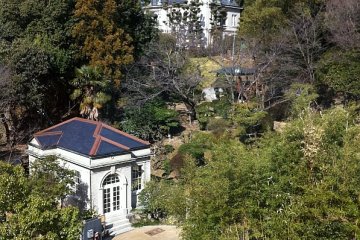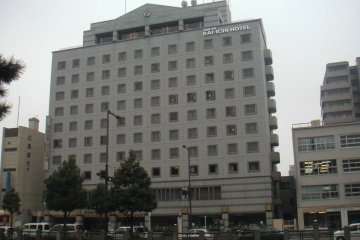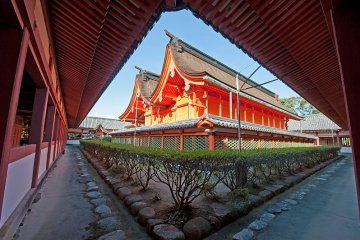
Visiting Bansuiso
AnonymousBansuiso is a large villa, built in a 19th Century somewhat Gothic French style. It sits at the base of the hill where the castle stands.

Most might not expect to find a French-style villa below Matsuyama Castle, but this elegant construction offers a respite from the bustling town center of Ehime. Bansuiso, largely hidden by trees and modern buildings, was originally the second Residence of Count Hisamatsu Sadakoto, a descendant of the Matsuyama samurai clan and former lord of the neighboring castle.
After living in France and returning with his love of Neo-Renaissance architecture, he commissioned the construction of the villa. Completed in 1922, it was the scene of numerous elite parties and social gatherings, and even welcomed members of the imperial family as guests, including Showa Emperor Hirohito.
Bansuiso serves as both a place of art and culture and a sight. The first floor and the basement are freely accessible and for ¥ 300 visitors can climb a wooden staircase to take advantage of more photo opportunities. Although the villa hosts solo exhibitions, it also has its own murals and portraits, including the portrait of the first owner.
5 minutes on foot from Okaido Station.

Bansuiso is a large villa, built in a 19th Century somewhat Gothic French style. It sits at the base of the hill where the castle stands.

Matsuyama is the capital city of Ehime Prefecture and the largest city in Shikoku. Its name means “pine mountain”. Matsuyama is a bustling city that has maintained its vitality despite the long recession in Japan that has hollowed out many other cities. Matsuyama has benefited from the leadership of two young mayors in succession, both of whom take a strong interest in tourism. The city has some excellent bars and restaurants, offering a choice of cuisines from around the world, in addition to regional specialities like boar and sea bream. Matsuyama is home to Dogo Onsen, the oldest hot spring bath house in Japan. Dogo Onsen is featured in the Michelin Green Guide, and was the inspiration for the hugely popular animation Spirited Away. Another favorite sight is Matsuyama Castle which sits atop a significant-sized hill in the middle of the city. Eight of the eighty-eight temples in the Shikoku Pilgrimage are located in Matsuyama, and pilgrims are a common sight making their way to the temples. Famous and picturesque Buddhist temples in Matsuyama include Ishite-ji, Taisan-ji, and Jodo-ji, all dating back to the 8th century. Ishite-ji is a particularly weird place, which includes an amazing series of tunnels in the hill behind it. Famous shrines of the city include Isaniwa Jinja and Tsubaki Jinja. In medieval times, Matsuyama was part of the Iyo-Matsuyama Domain, a fiefdom of Iyo Province consisting mainly of a castle town, with the village of Dogo Onsen to the east and a port to the west at Mitsuhama linking the region to the Japanese mainland and Kyushu. The haiku poet Masaoka Shiki lived in Matsuyama. His house, now known as the Shiki-do, and a museum, the Shiki Memorial Museum, are popular attractions, and the reason for the city’s role as the center of the international haiku movement. The novel Botchan by Natsume Soseki is set in Matsuyama. Despite the fact that Soseki pokes fun at the provincialism of the city, anything of note in the city is now called the Botchan this or that. Matsuyama also figures in several works by Shiba Ryotaro, particularly the 1969 novel, Saka no Ue no Kumo (Clouds Above the Hill). This was the focus of a major branding exercise undertaken by the previous major, which resulted in long-running NHK drama adaptation of the novel, and a museum designed by the renowned architect Tadao Ando. Another cultural site worthy of note is the Itami Juzo Museum dedicated to the famous film director. Physically, Matsuyama is quite a compact city. The center of the city is served by a tram system with beautiful tram cars from the 50s and 60s, as well as a picturesque replica steam train, the Botchan Ressha. The city is surrounded by mountains and incorporates a number of hills, giving it a green, rural feeling. Within the city limits are a number of sandy beaches facing the translucent waters of the Seto Inland Sea. The city still has many old buildings dating back to the Meiji Period and earlier. There are several stylish buildings by the architect Shichiro Giko, including the flamboyant Bansuiso Villa. Matsuyama Airport has regular flights to Tokyo, Osaka, and other major Japanese cities, as well as selected Asian destinations, including Shanghai and Seoul. There are regular ferries to Hiroshima, including an express ferry that takes only an hour. Night ferries go to Kobe, Kokura, and Kitakyushu.

The Tokyo Dai-ichi Hotel in the center of Matsuyama makes a good base for touring the city and its surrounding areas.

Sen Guesthouse in Dogo offers accommodation for tourists on a budget and pilgrims on the Shikoku 88 temple trail. The facilities are simple, but clean and comfortable.

Established in 2001, Café Kadan is one of the most well known café restaurants in Matsuyama. Café Kadan is what we call an oasis café with a lot of trees and flowers.

Honebuto Mikaku ramen on Ropeway Dori serves tonkotsu ramen topped with a great mound of sliced pork. The soup is garlicky.

Matsuyama and Ehime offer a variety of culinary specialties reflecting the geographic diversity of the region. The best advice is to dive in and try it all!

Matsuyama Castle is one of the twelve "original castles" in Japan, i.e. castles that have survived the post-feudal era since 1868 unscathed. It is located on the 132 meter high Katsuyama Mountain, which offers visitors a great view of Matsuyama and the Seto Inland Sea. With around 200 cherry trees on the castle grounds, Matsuyama Castle is a popular destination, especially when the cherry blossoms are in bloom. The castle was built between 1602 and 1628 and assigned to a branch of the Matsudaira family in 1635. It is an excellent example of a feudal castle. The Honmaru is located on the top of the hill and is accessible through several well-defended gates. The main tower is one of the few in the country that has multiple wings. The complex also includes a secondary keep and several towers. Inside the castle, some exhibits provide information about the history of Matsuyama and the feudal era.

The Botchan Railway Museum is designed as a museum for everyone. It tells the story of the Iyotetsu Railway, which has been available to the citizens of Matsuyama since it was founded in 1887. The exhibitions are entertaining even if you are not a huge railway fan yourself. A replica of the Iyotetsu No. 1 locomotive gives an insight into the scenery from the Meiji period. However, there are also individual railway sections and tracks from every era, a diorama of the old cityscape of Matsuyama and a selection of historical photos, so that the visitor can feel like on a journey through time.

Thought to be at least 1,000 years old, Isaniwa is one of Japan’s three shrines dedicated to the deity Hachiman. After climbing a long stretch of stone stairs, passing a double-story gate, a magnificent bright-red structure emerges. The architectural details are especially grand with the building’s swooping tile roofs, gold-leaf columns and ornate, cloudlike beam engravings. In addition to the spectacular architecture, there are displayed paintings of warriors and warfare (as Hachiman is the guardian of warriors and protector of Japan) and even numerous documents on Japanese mathematics. A hall of treasures features swords and armor for samurai history buffs. Other relics include animal paintings and calligraphy. Supposedly, Isaniwa Shrine originally marked the location where Emperor Chuai and Empress Jingu, who reigned in the third century AD, bathed at one of Japan’s oldest bathhouses, Dogo Onsen, now just a few hundred meters away. The shrine was moved to by the Kono samurai clan in the fourteenth century to the current location where, after conquering the stairs, you can enjoy breathtaking views of Matsuyama city. It was rebuilt in the 17th century by the Matsudaira clan; the current buildings with their great vermilion surface date from 1667. The original imperial bathers are enshrined there. Despite its age, the shrine is still buzzing with worshippers and even couples celebrating or taking pictures for their wedding. Although visitors note that the stairs are a little treacherous, the views and tranquil atmosphere only add to the experience of walking around the colonnade and absorbing a rich and long history—and if you’re lucky, observing a modern-day ceremony. If the trip does tire you out, you can always relax at Dogo Onsen at the foot of the compound.